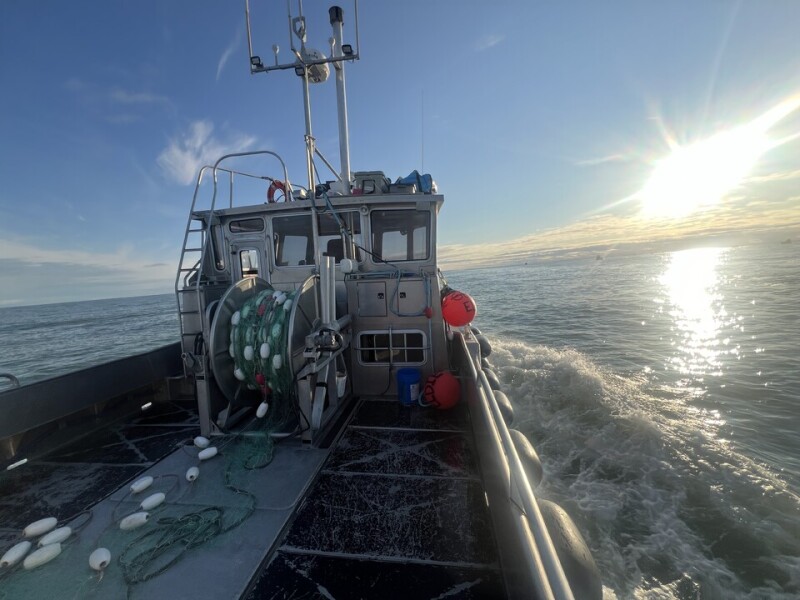Commercial fishing has been a part of my life for the last ten years, starting when I was just 15 years old. It is an amazing opportunity to unplug and relish the simplicity of long hours and hard, manual work. One of my big concerns while searching for my first desk job was if I would be able to continue this yearly tradition, so I was thrilled when I learned that Elliott Bay Design Group would be able to accommodate my love of fishing. At the end of June I set out for a three week break from work to go on an Alaskan adventure that is an important yearly ritual for me. As I stepped off the plane, I was filled with the feeling of adventure, the same feeling that always greets me as I first smell the salty sea air in King Salmon, Alaska.
For those unfamiliar with what drift gillnetting in a commercial fishery entails, let me give you some background. First, it's easiest to start off with a bit of background on the fishery, and the rules and restrictions. Bristol Bay consists of 5 districts: Togiak, Nushagak, Egegik, Ugashik and Naknek/Kvichak, each a unique river system with different salmon run sizes every year. For most of the season if you decide to transfer districts you are required to sit out of fishing for 48 hours. This makes transferring districts a risky strategy that doesn’t always pay off, but can often allow people to capitalize on the different river's natural salmon timing. Each district is regulated by the Alaska Department of Fish and Game which sets "Openers" (allowed time slots) when you can fish during the day. The idea of the opener is to allow enough escapement up into the river to foster the continuation of the salmon run year after year.
Next, I want to provide some background on the types of vessels used. As a marine engineer, I have always loved learning about the new tech and having yearly hands-on experience to see what my studies could be applied to. The fishing boats in the fishery I partake in are limited to 32 feet in length. However, there is no breadth restrictions, so as time has progressed and more and more equipment is required the boats have gotten wider; the widest boat I know of is nearly 20 feet wide! The fishing world is always a game of gaining slight edges over your competition; at one point in time there were boats that put wheels on the bottom so that they could drive onto the shore. Within my time up there the drive to get in as close to the beach as possible has introduced jet boats into the industry. These boats use jet propulsion systems similar to what a jet ski would use. On a large boat, these systems along with a very buoyant boat allows some people to fish in depths less than a foot deep hugging the shoreline where the fish often swim as they approach their home rivers. These boats are all generally equipped with a refrigerated seawater system that maintains fish temperature between 33-39 degrees, which guarantees that you, as the end consumer, get the freshest sockeye possible. At the end of every opener we deliver the fish to a tender. A tender boat is often a crab boat like those seen on Deadliest Catch. During the summer months, they use their cranes and their massive holding tanks to take the fisherman's fish and transport the fish to the processors. The processors then take the fish, filet and remove the bones, then ship them down to their local markets where you purchase the fish at the grocery store.
The process to catch the fish entails a 150-200 fathom long net that stretches down about 2 fathoms deep with a lead line below and corks above. Imagine a long scarf stretched out near the surface, forming a wall in the water. A gillnet has mesh holes that are approximately fish-head sized, and when the salmon swims into them it gets stuck underneath the gills. This fishery harvests sockeye salmon, and due to the timing and location of these runs it is very rare to experience much bycatch. Occasionally a few King Salmon are caught in the net but usually, due to their size, they hit the net and swim away. My job as a fish picker is to quickly get the fish unstuck from the net as it is pulled onto the boat. This task is very hard on the hands and forearms as each fish weighs around 5 lbs, and on a good day we may have to pick out over 2,000 fish. The job is physical and does not pause for rough weather. You are constantly stabilizing your body on the rocking of the waves, which leads to a level of exhaustion at the end of the day that is hard to find elsewhere. Towards the end of the season, we are only getting by on short naps between sets. The sleeping hours may be short, but it is definitely some of my favorite sleep.
With the background out of the way, I'd love to share the lessons I learned this year on the boat. Three weeks up there away from the internet and experiencing times of boredom or intense hard work leads to plenty of time stuck in your own head. I often use this time to reflect on the year behind me and formulate goals for the upcoming year. Another aspect of fishing I love is that due to the short harvest season, many hard life lessons can be learned in a short timespan. I feel I can extrapolate lessons learned from a brief three-week season to the rest of the year working as an engineer. The timelines are very different, but I think the lessons learned in each can be applied in both directions.
1. Hard work doesn’t guarantee success, it simply gives you the ability to capitalize once the opportunity arrives. We fished as hard as we could, but unfortunately, the fish just didn’t show up for most of the season. However, when they did come, we were able to gross nearly a quarter of our season in a single day when some fishermen just weren’t given the opportunity. The skills we honed when it was slow allowed us to maximize our opportunity when it came time.
2. Learning is a vital mindset to choose at every opportunity. After 10 years of fish picking, I thought I had learned most of the tricks, but was very surprised to still learn a few more from the other crew members.
3. Attitude is a choice, choose to be eager for life's opportunities. With the small harvest this year many fishermen were pessimistic, but I chose to try and face each day with a smile and hope that we would find the fish when it mattered, which turned out to be true.
4. Seeking downtime and reflection is vital for growth, being bored allows reflection on who you want to become. As uncomfortable as it feels I think you must seek out slow moments or else life will pass you by and you will lack the time to think about who you are and what you want to become.
5. It takes bad times to know when life is good, since it requires contrast to truly appreciate the good times. I think it's better to live life like each year is your best year yet since you won't really know until you have your worst year. After 5 record-breaking seasons we always wanted more fish, but it was humbling to realize there were many seasons like this year where fishermen were still happy with their catch. I wished I had of appreciated the record runs more when I was living them.
6. On a less serious note, learn to go with the uncontrollable. I had a few baking adventures that did not go as planned as a small diesel stove taught me that sometimes a 30 minute pie will take 2 hours, and the only option is to do the best you can.
7. Desk jobs are pretty awesome, it only took a few days of getting hit with waves and seeing the rain being blown upwards before I realized that sitting behind a desk certainly has its perks. So today I happily write this in a cool office space with a fresh apple and a coffee right next to me smiling at the simple luxuries this job provides.







